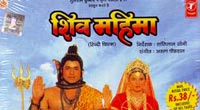
A ghoonghat (ghunghat, ghunghta, ghumta, odhni, laaj, chunari, jhund) is a veil or headscarf worn by some married Hindu, Jain and Sikh women to cover their head, and often their face. Generally aanchal or pallu, the loose end of a sari is pulled over the head and face to act as a ghunghat. A dupatta (long scarf) is also commonly used as a ghungat. Today, facial veiling by Hindu women as part of everyday attire is now mostly limited to the Hindi-speaking areas of India.
Facial veiling is not sanctioned in Hinduism, Jainism, Buddhism and Sikhism but some sections of the society from the 1st century B.C. advocated the use of the veil for married women, which came to be known as ghoonghat. It has been both romanticized and criticized in religious and folk literature.
Contents
Etymology
The word ghoongat, ghunghat or ghunghta is derived from Avagunthana (Sanskrit: ????????) meaning veil, hiding and cloak and Oguntheti (Pali: ?????????) to cover, veil over and hide.
History
The ghoongat, ghunghat or ghunghta veil evolved from ancient Avagunthana in (Sanskrit: ????????) veil, hiding and cloak. Early Sanskrit literature has a wide vocabulary of terms for the veils used by women, such as avagunthana meaning cloak-veil, uttariya meaning shoulder-veil, mukha-pata meaning face-veil, and sirovas-tra meaning head-veil.
In Valmiki's Ramayana dated between the 5th century BCE to the first century BCE, Prince Rama asks his wife Sita to unveil herself so that the gathered citizens of Ayodhya can take a look at them before they go in exile to the forest; there is no mention of Sita veiling herself again after this incident. At the end of the epic, hearing the news of Ravana's death, his queens giving up to lamentations rush outside without their Avagunthana, in which chief queen Mandodari surrounding his corpse says "Why do you not get angry, beholding me, having put off my veil, walk out on foot by the city gate? Do you behold your wives who have thrown off their veils. Why are you not angry seeing them all come out of the city?" Thus, it is notable that royal women avoided public gaze and veiling was expected to be worn only by married women.
??draka, the author of M?cchakatika set in the fifth century BC, said that the Avagaunthaha was not used by women everyday and at every time. He said that a married lady was expected to put on a veil while moving in the public. This may indicate that it was not necessary for unmarried females to put on a veil.
In M?cchakatika written in 3rd century BCE, courtesan Vasantasena's mother, having received ornaments for her daughter from a wealthy suitor to keep her as his mistress, she sends Vasantasena with her maid, asks her to go in the carriage bedecked with ornaments and to put on her avagunthana veil. This instruction is taken to signify that a courtesan who has accepted a suitor, had to use a veil in public similar to married women. At the end of the play when Vasanthasena is legally wedded, she receives the title "Vadh??abda" meaning "title of a bride" simultaneously with the veil "vasantasen?m avagunthya" meaning "a token of honorable marriage". In the same literature, courtesans' maid servant Madanika marries her lover Sarvilaka, a thief who changes his ways. Her new husband says to her that she has achieved what is difficult to acquire: "Vadh??abda avagunthanam" meaning "the title and veil of a bride".
In the Pratim?n?taka, a play by Bh?sa (3 - 4 CE) describes in context of the Avagunthana cloak-veil that "ladies may be seen without any blame in a religious session, in marriage festivities, during a calamity and in a forest". The same sentiment is more generically expressed in N?g?nanda and Priyadar?ik? by Harsha, where maidens were expected to wear no veil; it was donned only after the marriage. Later, the veil was referred to by the same term, avagunthana, in ?i?up?lavadha and the Dashakumaracharita. According to commentator Sankara, the ladies of Sthanvisvara used to go about covering their faces with a veil.
In Buddhist Mahayana literature, Lalitavistara S?tra written in the 3rd century CE, young bride Yasodhar? objected to observe veiling (oguntheti/ogu?thik?) in front of respected elders. This was taken to be a sign of immodesty and willfulness, as people criticized her and gossiped. When she became aware of this, Yasodhar? came before the assembled court and defended herself in a long statement: "Those whose thoughts have no cover, no shame or decorum or any virtue, those who gossip, may cover themselves with a thousand garments, yet they walk the earth naked. But those who veil their minds, control their senses, and have no thought for any other except their husband, why should they veil their faces?" Yasodhar?'s parents-in-law were delighted with their daughter-in-law's proud statement and gave her two white garments covered with jewels.[22]
The Lalitavistara S?tra reflects changing times around the 3rd century CE and Buddhists' attempt to counter this growing practice, as there is no mention of this entire incident in early Buddhist Theravada literature.[23][24]
In Abhijñ?na??kuntalam by K?lid?sa, written between the 3rd and 4th century CE, when the heroine arrives at King Duhsanta's palace, seeking to take up her wifely status, the king first remarks "K? svid avagunthanavati" meaning "who is this veiled one?" and immediately forbears to look at her, with the words "Anirvarnaniyam parakalatram" meaning "The wife of another is not to be inspected."[25] This largely indicates that Avagunthana was a sign of a respectable married woman, and was a married woman's raiment.[26]
Medieval period
In Kath?sarits?gara written in the 11th century AD, heroine in the story Ratnaprabh? protesting: "I consider that the strict seclusion of women is a folly produced by jealousy. It is of no use whatsoever. Women of good character are guarded only by their own virtue and nothing else."[27] Rational opposition against veiling and seclusion from spirited ladies resulted in the system not becoming popular for several centuries.[28] However, it is notable that some section of society from the 1st century B.C. advocated the use of the veil for married women. There is no proof that a large section of society observed strict veiling until the medieval period.[29]
Under the Islamic Mughal Empire, various aspects of veiling and seclusion of women was adopted, such as the concept of Purdah and Zenana, partly as an additional protection for women.[30] Purdah became common in the 15th and 16th century, as both Vidy?pati and Chaitanya mention it.[31] Sikhism was highly critical of purdah; Guru Amar Das condemned it and rejected seclusion and veiling of women, which saw decline of purdah among most classes during this period.
Significance
In ghoonghat practice, facial veiling observed by married women is known as Laaj (Sanskrit: ?????, Lajja - modesty, honor, shame). In veiling practice, it literally means "To keep (one's) modesty, shame and honor". Earliest attested word Laaj in context of veiling is found in Valmiki's Ramayana as lajjaavaguNThanaan describing Mandodari.[11] However, it is unclear whether it refers to facial veiling.[32]
During a marriage ceremony, the bride wears a veil given by her parents. Later, during the ceremony the bride's mother-in-law covers her face with ghoonghat; she therefore simultaneously wears the veil given by her parents and that from her in-laws, symbolizing her passing from the protection of one's household to another.[33]
Muh Dikhai (Devanagari: ??? ?????, first gaze) is a post-wedding ceremony, where the bride is formally introduced to the groom's relatives and extended family. The ceremony takes place once the bride arrives in her new home; each family member lifts her veil, looks at the bride and gives her a welcoming gift. She receives Shagun from her mother-in-law, which is typically jewelry, clothing and silverware. After this ceremony the bride observes full veiling for the next few months or until her parents-in-law advise her to unveil.[34]
Post-1900s
During the early 1900s, women of royal and aristocratic class were first to abandon strict veiling in public. However, the head was loosely veiled due to sensitivity towards the custom during changing times.[35] The other classes soon followed; it lingered on in some parts of India until well after the 1940s. Facial veiling has gradually declined, and is mostly limited to parts of Hindi-speaking areas today.[36] In ghungat, a woman will veil her face from all men to whom she's related by marriage and who are senior to her husband. This would include, for example, her husband's father, elder brother and uncles. The effect of ghungat is to limit a young woman's interaction with older men.[37][38]
In 2004, the India Human Development Survey (IHDS) found that 55% of women in India practice some form of ghoonghat, majority of them in Hindi-speaking states.[39] The survey found that some women may cover their face fully but for others, partial covering of the face is more a nod to propriety than a large impediment.[40]
Gallery

Request Movie Now
Watch movie Ghunghat online on Amazon
Watch movie Ghunghat online
Watch The Movie On Prime
Shiv Mahima Full HD Movie Download

Champion Full HD Movie Download

Buddhivantha Full HD Movie Download

Saath Saath Full HD Movie Download

Kudrat (1998) Full HD Movie Download
.jpg)
Ghar Ghar Ki Kahani (1988) Full HD Movie Download
.jpg)
Sindoor (1987) Full HD Movie Download
.jpg)
Baarish (1957) Full HD Movie Download
.jpg)
Jaan Hatheli Pe Full HD Movie Download

Gumnaam (1965) Full HD Movie Download
.jpg)
Aandhi Toofan Full HD Movie Download

Ganda Hendathi Full HD Movie Download

Agni Satchi Full HD Movie Download

Final Destination 3 Full HD Movie Download

Swimming Pool Full HD Movie Download

Rush Hour Full HD Movie Download

Imayam Full HD Movie Download

Muddulu Priyudu Full HD Movie Download

Micheal Madana Kama Raju Full HD Movie Download

Devadasu Malli Puttadu Full HD Movie Download

Pandanti Kapuram Full HD Movie Download


Download latest Movie from bollywood
- 1> baaghi 3
- 2> THE SKY IS PINK MOVIE FULL STORY AND REVIEW
- 3> Luka Chuppi
- 4> TO ALL THE BOYS I’VE LOVED BEFORE
- 5> Kabir Singh
- 6> Street Dancer 3D
- 7> Simmba
- 8> Gone Girl
- 9> The Girl Who Lived
- 10> Ludo
- 11> DILWALE DULHANIA LE JAYENGE
- 12> GUILTY
- 13> The Godfather
- 14> Adventures of Rusty
- 15> Sooryavanshi
- 16> Satyameva Jayate 2
- 17> Thappad
- 18> Bhool Bhulaiyaa 2
- 19> KGFChapter 2
- 20> Mardaani 2
- 21> Pinjar
- 22> Shivaji maharaj
- 23> Ek Villian 2
- 24> Hungama 2
- 25> Divergent
- 26> Mumbai Saga
- 27> The Internship
- 28> HIT (telugu)
- 29> Panga
- 30> The perfect date
- 31> 16 December
- 32> Gopala Gopala (Telugu)
- 33> Brahmastra
- 34> Gangubai Kathiawadi
- 35> Manmadhudu
- 36> Nenu local
- 37> Mahanati
- 38> Shatamanam bavathi
- 39> Lagaan
- 40> After
- 41> MOM
- 42> Shamshera
- 43> Raguvaran BTech
- 44> Khakee
- 45> The villain
- 46> OM
- 47> Mr. perfect
- 48> Bueatifull mind
- 49> Hichki
- 50> Gabbar Singh
- 51> Jogi
- 52> Before Sunrise
- 53> Before Sunset
- 54> Before Midnight
- 55> The Big Bull
- 56> Top Gun: Maverick
- 57> The Purge
- 58> The Sky is Pink
- 59> Laxmmi Bomb
- 60> Sadak 2
- 61> Sufna
- 62> Prithviraj
- 63> PK
- 64> Coolie No 1(2020)
- 65> Black Widow
- 66> Dear Zindagi
- 67> Dil Bechara
- 68> PHIR HERA PHERI
- 69> WAR
- 70> Dostana
- 71> RRR: Roudram Ranam Rudhiram
- 72> Maidan
- 73> Dabbang 3
- 74> Chhalaang
- 75> life as we know it
- 76> SherShaah
- 77> Sandeep Aur Pinky Faraar
- 78> Event Horizon
- 79> 83
- 80> Radhe: Your Most Wanted Bhai
- 81> Gunjan Saxena: The Kargil Girl
- 82> Mr India
- 83> Vivah
- 84> Anokha Bandhan
- 85> Ghost
- 86> Bhoot: Part One - The Haunted Ship
- 87> Haseen Dilruba
- 88> Laal Singh Chaddha
- 89> Qismat
- 90> Rajput
- 91> Drive
- 92> Dil Chahta Hai
- 93> Dil Ki Baazi
- 94> Dil Ka Rishta
- 95> Teesri Manzil
- 96> Dil
- 97> Love Aaj Kal
- 98> Khaali Peeli
- 99> Bunty Aur Babli 2
- 100> Atrangi Re
- 101> Gulabo Sitabo
- 102> Jodi
- 103> Suraj Pe Mangal Bhari
- 104> Deewana
- 105> Attack
- 106> Sardar Udham Singh
- 107> Toofan
- 108> THE LOVEBIRDS
- 109> Jersey
- 110> Ginny Weds Sunny
- 111> Thalaivi
- 112> Shiddat
- 113> Angels vs Zombies
- 114> Koi Mil Gya
- 115> Thank God
- 116> Bhuj: The Pride of India
- 117> Hum Aapke Hain Kaun
- 118> The Platform
- 119> Bird Box
- 120> Roohi Afzana
- 121> Torbaaz
- 122> Nikamma
- 123> World War Z
- 124> Extraction
- 125> Train to Busan
- 126> Life of Pi
- 127> SHAADI MEIN JROOR AANA
- 128> Himmat Aur Mehnat
- 129> To All The Boys: P.S. I Still Love You
- 130> Mimi
- 131> Good Newwz
- 132> Shubh Mangal Zyada Saavdhan
- 133> Raabta
- 134> Harry Potter and the Philosopher's Stone
- 135> Harry Potter and the Chamber of Secrets
- 136> Chhapaak
- 137> War of the Worlds
- 138> Harry Potter and the Prisoner of Azkaban
- 139> Harry Potter and the Goblet of Fire
- 140> MURDER MYSTERY
- 141> Shakuntala Devi
- 142> Bachchan Pandey
- 143> Jayeshbhai Jordar
- 144> Sheer Qorma
- 145> Saina
- 146> 'O' Pushpa I hate tears
- 147> Kedarnath
- 148> MS Dhoni The Untold Story
- 149> Chhichhore
- 150> Badhaai Ho
- 151> Unstoppable
- 152> Oz the Great And Powerful
- 153> The Girl on the Train
- 154> Haathi Mere Saathi 2020
- 155> The Conjuring: The Devil Made Me Do It
- 156> Gandhi Se Pehle Gandhi
- 157> The Song of Scorpions
- 158> Srimanthudu
- 159> Hello Guru Prema Kosame
- 160> Beauty and The Beast
- 161> Black Panther
- 162> Charlie and the Chocolate Factory
- 163> Bole Chudiyan
- 164> Fidaa
- 165> Duvvada Jagannadham
- 166> Bruce Lee: The Fighter
- 167> Hyper
- 168> Yaara
- 169> Red (2020)
- 170> Shivam
- 171> That Is Mahalakshmi
- 172> Nishabdham
- 173> Aashram 2020 web series
- 174> Laxmii
- 175> Mismatched
- 176> STUDENT OF THE YEAR 2
- 177> NAIL POLISH
- 178> Ramprasad Ki Tehrvi
- 179> KAAGAZ
- 180> 12 o Clock
- 181> The Power
- 182> bolo hau
- 183> Tribhanga
- 184> JAMUN
- 185> Madam Chief Minister
- 186> Maasaab
- 187> Aadhaar
- 188> Tanhaji
- 189> Bhaagi 3
- 190> Bhootnath
- 191> MALANG
- 192> Jai Mummy Di
- 193> Haathi Mere Saathi 2021
- 194> Shakeela
- 195> Unpaused
- 196> Annayya
- 197> Vamsoddharakudu
- 198> Mrugaraju
- 199> Narasimha Naidu
- 200> Sankranti
- 201> Manasu Maata Vinadhu
- 202> Anjaane
- 203> Apaharan
- 204> Bachke Rehna Re Baba
- 205> Bewafaa
- 206> Roohi
- 207> Radhe
- 208> Zindagi Khoobsoorat Hai
- 209> Yeh Mohabbat Hai
- 210> Yeh Kya Ho Raha Hai?
- 211> The Tomorrow War
- 212> DehradunDiary
- 213> Meri Shaadi Karaoo
- 214> Matruu Ki Bijlee Ka Mandola
- 215> No One Killed Jesica
- 216> Aag Ka Goola
- 217> Eight Million Dollars
- 218> Three Hundred
- 219> Cats and Dog
- 220> Decoy
- 221> Gold Rush
- 222> You Have Got Mail
- 223> Final Destination three
- 224> Tofan
- 225> Jungle
The valuable critic review of movie Ghunghat is availeble for downloadAs PCDS members You can use other service that depends on your credit balance and availability of movie. Credit balance earnig is very easy you can earn by using service of the pcds or let to your friends know about this.Request for Download movie Ghunghat
Are you looking for work in Movie in the bollywood ?Type of works in bollywood like Actor, Actress, singer, director, scriptwriter, Model, Play Back Singers, Script writer, Dialogue Writer, Audiography, Background Music, Costume Designer, Choreographer or junior artist
- Bollywood movies
- Latest Bollywood movies
- Download all bengali movies
- Download all bhojpuri movies
- Download all english movies
- Download all gujarati movies
- Download all hindi movies
- Download all kannada movies
- Download all malayalam movies
- Download all marathi movies
- Download all oriya movies
- Download all punjabi movies
- Download all tamil movies
- Download all telugu movies
- Bollywood action movies
- Bollywood adventure movies
- Bollywood animation movies
- Bollywood classical movies
- Bollywood comedy movies
- Bollywood crime movies
- Bollywood devotional movies
- Bollywood documentary movies
- Bollywood drama movies
- Bollywood family movies
- Bollywood fantasy movies
- Bollywood historical movies
- Bollywood history movies
- Bollywood horror movies
- Bollywood musical movies
- Bollywood mystery movies
- Bollywood mythological movies
- Bollywood patriotic movies
- Bollywood romance movies
- Bollywood romantic movies
- Bollywood sci-fi movies
- Bollywood social movies
- Bollywood spiritual movies
- Bollywood sports movies
- Bollywood suspense movies
- Bollywood thriller movies
- Bollywood war movies
- Hot actress list
- Hot gujarati actress list
- Hot tamil actress list
- Hot bhojpuri actress list
- Hot assam actress list
- Hot bihari actress list
- Hot jammu and kashmir actress list
- Hot gujarati actress list
- Hot haryana actress list
- Hot konkani actress list
- Hot marathi actress list
- Hot odia actress list
- Hot punjabi actress list
- Hot rajasthani actress list
- Hot kannada actress list
- Hot malayalam actress list
- Hot telugu actress list
- Hot tulu actress list
- Hot Actress list from Indian city
- Hot actress list from ahmedabad
- Hot actress list from alappuzha
- Hot actress list from bangalore
- Hot actress list from bangalore
- Hot actress list from bhopal
- Hot actress list from chandigarh
- Hot actress list from chennai
- Hot actress list from guwahati
- Hot actress list from hyderabad, india
- Hot actress list from indore
- Hot actress list from jaipur
- Hot actress list from kannur
- Hot actress list from kochi
- Hot actress list from kolkata
- Hot actress list from kollam
- Hot actress list from kottayam
- Hot actress list from kozhikode
- Hot actress list from lucknow
- Hot actress list from madurai
- Hot actress list from mangalore
- Hot actress list from mumbai
- Hot actress list from mysore
- Hot actress list from new delhi
- Hot actress list from patna
- Hot actress list from pune
- Hot actress list from thiruvananthapuram
- Hot actress list from thrissur
- Hot actress list from tiruchirappalli
- Hot actress list from vijayawada
- Hot actress list from visakhapatnam
- All Bollywood Movies
- Bollywood Celeb
- >Art Director
- >Audiography
- >Background Music
- >Banner
- >Choreographer
- >Cinematographer
- >Costume Designer
- >Dialogue Writer
- >Director
- >Distributor
- >Editor
- >Executive Producer
- >Hair Stylist
- >Lyricist
- >Music Director
- >Photographer
- >Playback Singers
- >Presenter
- >Producer
- >Production Company
- >Production Designer
- >Screenplay
- >Singer
- >Sound
- >Actor
- >Story Writer
- >Studio
- >Video Director
- >Miscellaneous
- >Publicity (pro)
- >Web Creator
- >Production Labs
- >Publicity Design
- >Publicity Stills
- >Writer
- >Miscellaneous Artists
- >Visual Effects
- >Reporter
- >Music Company
- >Shooting Studios
- >Picturised On
- >Line Producer
- >Co Producer
- >Asst Director
- >Casting Director
- >Cinematography
- >Choreography
- >Dialouge
- >Editing
- >Lyrics
- >Music
- >Story
- >Playback Singer Female
- >Playback Singer Male
- >Actor In A Comic Role (male/female)
- >Child Artiste
- >Ensemble Cast
- >Actor Popular Choice (male)
- >Actor Popular Choice (female)
- >Sa Re Ga Ma Pa Song Of The Year
- >Actor In Supporting Role
- >Actress In Supporting Role
- >Actor In Leading Role
- >Art Direction
- >Actress In Leading Role
- >Sound Recording
- >Costume Design
- >Special Effects
- >Action
- >Actor In A Negative Role
- >Lifetime Achievement Award
- >Cinematic Exellence (director)
- >Cinematic Exellence (male)
- >Cinematic Exellence (female)
- >International Male Icon
- >International Female Icon
- >Actor In A Supporting Role (male)
- >Actor In A Supporting Role (female)
- >Actor In A Comic Role
- >Playback Singer (male)
- >Playback Singer (female)
- >Most Promising Debut (female)
- >Most Promising Debut (male)
- >Most Promising Director
- >Sound Design
- >Lifetime Jodi
- >Marketed Film
- >Jury Award For Best Actor
- >Jury Award For Best Actress
- >Jury Award For Best Film
- >Jury Award For Best Director
- >Playback Singer(male)
- >Lifetime Acheivement Award (male)
- >Excellence Award
- >Jodi Award
- >Performer Of The Year
- >Presented By
Disclimer: PCDS.CO.IN not responsible for any content, information, data or any feature of website. If you are using this website then its your own responsibility to understand the content of the website